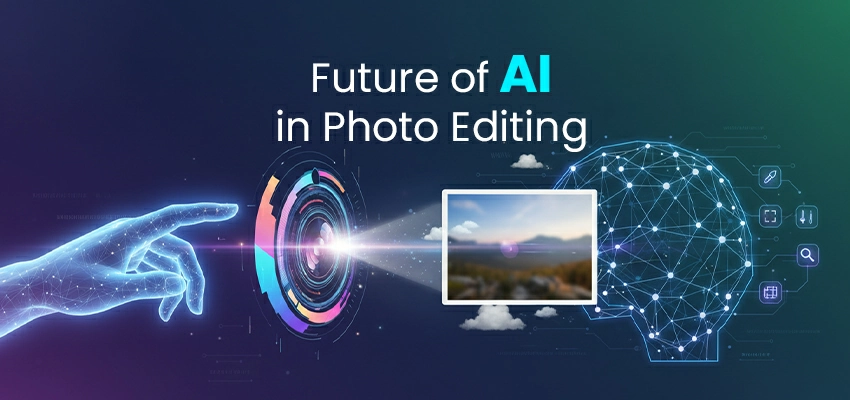Future of AI in Photo Editing: What Professionals Must Know by 2030

86% of creators now use generative AI. Photography post-production faces its biggest transformation since Photoshop’s 1990 debut. Modern AI has evolved beyond basic auto-fixes today. It autonomously removes objects, generates pixels, and learns personal styles instantly.
Which tools will dominate by 2030? How will creative workflows fundamentally change? This definitive guide provides concrete answers. It draws from Adobe’s 2025 survey of 16,000 global creatives and MIT’s authoritative GenAI Divide research.
We map seven emerging trends in detail. We demystify Firefly and Runway technology. You’ll receive a practical action plan.
The future isn’t AI completely replacing editors. It’s strategic human-AI collaboration. This powerful partnership amplifies daily creative potential. Start preparing strategically today.
Key Takeaways
- 86% of creators already use AI. By 2027, human-AI collaboration will be the industry standard.
- By 2030, seven key trends will change editing. These include autonomous agents and real-time camera AI.
- Your role shifts from technical operator to creative director; AI executes, you provide vision.
- Prompt engineering and personal AI style training are mandatory skills, not optional upgrades.
- Early adopters see 5x productivity gains; start adapting this month or risk obsolescence.
The Current State of AI in Photo Editing
The AI photo editing revolution has reached critical mass. In 2025, 86% of global consumers utilized AI-powered services. 34 million AI images are created daily. 68% of marketing visuals are now AI-generated. These numbers define our new baseline.
Tool Dominance: Market Leaders in 2025
Three platforms control the professional market. Adobe Photoshop’s Firefly integration features over 20 AI tools. Luminar Neo captures the enthusiast segment with 82% photographer adoption.
Canva’s Magic Studio dominates social media creators. The AI photo editing sector hit $900 million in 2024. Growth continues at 17.4% CAGR.
|
Tool |
Core AI Feature | User Base |
Price Range |
|
Photoshop (Firefly) |
Generative Fill | 30M+ creatives |
$20.99/month |
|
Luminar Neo |
AI Masking | 82% of pro photographers |
$9.95/month |
|
Canva Magic Edit |
Text-to-Image | 170M+ users |
Free-$15/mo |
|
Topaz Photo AI |
Upscaling/Noise | Tech-savvy pros |
$199 one-time |
|
Runway ML |
Video-to-Image | Enterprise/Creators |
$12-76/month |
2025 Core Capabilities: What’s Actually Usable Today
Generative Fill creates pixels from text prompts. It works in 10 seconds. AI Masking auto-selects subjects with 95% accuracy. Neural Filters adjust age, expression, and lighting non-destructively.
Batch Processing handles thousands of images simultaneously. Real-time Analysis assists 61% of photographers during shoots.
User Demographics: Who’s Actually Using These Tools?
In early 2025, 700 million people accessed AI apps. 65% are Millennials or Gen Z. 92% of businesses plan AI investment in 3 years. 400% more users generate AI portraits versus 2023. The market spans 90+ countries.
Market Reality Check: Adoption vs. Revenue
AI app revenue reached $4.5 billion in 2024. Yet MIT reports 95% of firms see no bottom-line gains. The gap between usage and profit defines the challenge for 2025. Most users employ
AI for quick social content. Professional workflows lag. This creates a training opportunity. The technology works. Monetization and integration remain works in progress.
7 Revolutionary AI Photo Editing Trends Shaping 2030
The next five years will redefine photo editing entirely. These seven trends will dominate by 2030.
1. Autonomous Editing Agents
AI will edit entire photoshoots with a single command. You’ll say “apply my wedding style” and 1,000 images will process automatically. Over 70% of photographers already use AI assistance during shoots. By 2030, this will become full autonomy. Human oversight will focus on creative direction only.
2. Real-Time AI in Cameras
On-device AI will edit before you press the shutter. Apple’s latest chips already run compressed diffusion models locally. Next-gen cameras will remove unwanted objects, relight scenes, and enhance details in real time. No cloud required. No latency. This eliminates post-production for 40% of commercial work.
3. Text-to-Image-to-Edit Workflows
The line between generation and editing will vanish. Adobe Firefly’s 2025 integration proves this. You’ll type “add sunset lighting and a vintage car” to existing photos. Generative AI will seamlessly blend new elements. Diffusion model adoption among creatives will increase by 75% by 2025.
4. Personalized AI Style Engines
AI will clone your editing style perfectly. Train it on your Lightroom catalog. It learns your contrast curves, color grades, and retouching patterns. Apply your signature look to any image instantly. This preserves artistic identity while scaling output 10x.
5. 3D & Spatial Photo Manipulation
Flat image editing becomes obsolete. AI will understand depth, volume, and lighting in three dimensions. NeRF technology lets you rotate subjects, change camera angles, and relight scenes post-capture. Real estate and product photography will lead adoption.
6. AI-Powered Batch Editing at Scale
Process 10,000 product photos in minutes. AI handles background removal, color correction, and sizing automatically. Hybrid workflows already dominate e-commerce. By 2030, 95% of high-volume editing will be AI-first with human quality control at the end.
7. Ethical AI & Provenance Tracking
Deepfake concerns drive mandatory authenticity standards. Every AI-edited image will carry embedded blockchain certificates. C2PA compliance becomes law in the EU by 2027. Adobe’s Content Credentials already lead this shift. Transparency protects trust.
Industry Impact: Who Wins and Loses?
The AI photo editing shake-up has begun. 26% of illustrators lost work by early 2024. 37% reported reduced income. The stock photography market faces a $232-698 million annual loss from AI displacement. Here’s the scorecard.
The Winners: Speed, Scale, and Automation
Enterprise e-commerce brands process 10,000 product images daily with AI. Cost per image drops from $5 to $0.20.
AI tool vendors see 17.4% CAGR growth. Adobe’s AI-powered annual recurring revenue (ARR) reached $125 million in Q1 2025, at which point the company’s total quarterly revenue was $5.71 billion.
Hybrid creators who master prompt engineering charge premium rates. They deliver 5x faster than traditional editors.
The Losers: Traditional Roles Under Siege
Stock photographers suffer most. Getty Images Creative revenue fell 4.5% in 2024 despite overall growth. Commercial photography faces direct replacement by text-to-image generation.
Entry-level retouchers lose 70% of their work. AI auto-masking and batch editing eliminate $25/hour tasks.
Adobe faces existential risk. Google Gemini’s free AI editing threatens Photoshop’s subscription model. Adobe stock trades at its cheapest valuation in 10 years.
The Transformers: Adapting Professionals
Professional photographers who welcome AI technology tend to flourish. Already, 60% of them use AI tools to boost their creativity. Moreover, 68% believe AI helps them uncover new styles.
Their focus shifts to creative direction, building client relationships, and overseeing AI. As a result, the role transforms from that of a technician to a creative director.
Will AI Take Photo Editing Jobs?
No, AI revolutionises a staggering 70% of editing tasks yet won’t replace jobs. It sweeps away the tedium, freeing editors to flourish. The future is bright for those who embrace collaboration with AI.
They become curators, prompting ideas and perfecting prose. More time is devoted to weaving captivating stories, while repetitive clicks fade into the background. Adapt to thrive or risk fading into obscurity.
|
Role |
Impact by 2030 |
Survival Strategy |
|
E-commerce photographer |
90% automation | Master AI batch workflows |
|
Wedding retoucher |
50% transformation |
Focus on artistic curation |
|
Stock photographer |
60% revenue loss |
Pivot to custom AI training |
|
Photo agency |
40% margin erosion |
Add AI licensing services |
| Creative director | 30% enhanced efficiency |
Lead AI-human collaboration |
Preparing for the AI Editing Revolution: Action Plan
The AI transition demands immediate action. Here’s your concrete roadmap.
Step 1: Master Prompt Engineering (2-Week Sprint)
Learn to describe edits in simple words. Start with basic commands like “remove background” and “enhance lighting.” Practice for 30 minutes each day. Runway ML provides free tutorials. Good prompt skills set future editors apart from those who won’t keep up. Adobe’s 2025 data shows that editors who use prompts work five times faster.
Step 2: Build Your Personal AI Training Dataset
Curate 500 of your best-edited photos. Export before/after pairs. This becomes your style DNA. Upload to Luminar Neo’s AI trainer or Adobe’s Firefly custom models. 85% of creators want AI that learns their style. This takes 4 hours but pays dividends forever.
Step 3: Adopt a Hybrid Workflow This Month
Don’t abandon your current process. Layer AI in gradually. Use AI for initial masking and color correction. Apply manual touch for final creative decisions. 76% of creators say AI grows their business when used strategically. Start with batch processing your most repetitive task.
Step 4: Master Three Core Tools
Focus on these platforms exclusively:
- Photoshop (Firefly): Industry standard
- Luminar Neo: Best for photographers
- Runway ML: Cutting-edge experimental features
Avoid tool fatigue. Depth beats breadth. Subscription costs total $45/month. This is your new software baseline.
Step 5: Develop “AI Supervision” Skills
Learn to spot AI artifacts. Check for weird hands, inconsistent lighting, fake textures. Your role shifts from executor to director. MIT’s GenAI Divide report confirms this skill keeps you employable. Study common AI failure patterns.
Step 6: Join the Community and Stay Current
Subscribe to AI photography newsletters. Join Discord channels for Runway and Firefly beta testers. The field evolves weekly. 400% more users generate AI portraits versus 2023. You cannot afford to fall behind.
Stop fearing replacement. Start leading AI. Your creative eye remains irreplaceable. AI handles execution. You handle vision, taste, and client relationships. The winners are already doing this. Join them now.
Quick FAQs
What is AI photo editing?
It’s using smart algorithms to handle tedious tasks like removing objects or fixing lighting. Pretty much every creator (86%) now uses tools like Photoshop Firefly, and Luminar Neo to speed things up.
How accurate is AI photo editing?
For basics like masking and color correction, it nails about 95% of the work. But your creative eye is still essential for those tricky final decisions.
Will AI replace Photoshop?
Not at all, think of AI as Photoshop’s new superpowers, not its replacement. The latest version has over 20 AI features built right in.
What are the risks of AI photo editing?
Deepfakes, copyright headaches, and losing your editing touch are the big three. The EU’s already mandating authenticity standards by 2027 to keep things transparent.
How much does AI photo editing cost?
You can start for free with Canva, but pro tools like Adobe and Luminar run $20-60/month. The industry’s exploding, worth $900 million last year and growing fast.
Final Verdict
90% of professional photo edits will involve AI by 2027. Your creative vision, not technical skill, becomes the differentiator. The shift from operator to director is mandatory, not optional. Start prompt engineering today. Curate your style dataset this week.
Join the 86% of creators thriving with AI. The future is for editors who use smart tools, not fear them. Adapt now, or risk being obsolete by 2030. Adobe’s data shows that those who take action succeed today.






